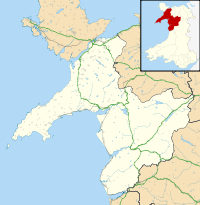- St Cynhaearn's Church, Ynyscynhaearn
-
St Cynhaearn's Church, Ynyscynhaearn 
St Cynhaearn's Church, Ynyscynhaearn, from the westLocation in Gwynedd Coordinates: 52°55′34″N 4°11′40″W / 52.9262°N 4.1945°W OS grid reference SH 525 387 Location Near Pentrefelin, Gwynedd Country Wales Denomination Church in Wales Website Friends of Friendless Churches History Dedication Saint Cynhaearn Architecture Functional status Redundant Heritage designation Grade II* Designated 19 October 1971 Architectural type Church Groundbreaking 12th century Completed 1622 Specifications Materials Stone with slate roofs St Cynhaearn's Church, Ynyscynhaearn, is a redundant church standing in an isolated position on a former island in Llyn (Lake) Ystumllyn,[1] 900 metres (980 yd) south of the village of Pentrefelin, Gwynedd, Wales (grid reference SH 525 387). It has been designated by Cadw as a Grade II* listed building.[1] The church is approached from the village by an ancient causeway,[2] and is in the care of the Friends of Friendless Churches.[2]
Contents
History
The church was originally the parish church for Porthmadog.[1] Its nave dates from the 12th century, and the north transept was added in the 16th century.[2] The south transept was built in 1622.[1] Most of the interior fittings are Georgian in style and date from 1832. It came into the care of the Friends of Friendless Churches in 2003, since when repair work has been undertaken.[2]
Architecture
Structure
It is constructed in stone rubble, with the walls of the nave and the east side of the chancel being stucco. The roofs are of modern slates. Its plan consists of a short nave, north and south transepts, and a short chancel. At the west end is a bellcote. The entrance is through a west door. The windows in the nave and transepts have two lights, and at the east end are three lancet windows. The interior is plastered above a timber dado. The floor of the body of the church is stone-flagged, and there is a painted floor in the sanctuary. At the west end is a gallery.[1]
Fittings and furniture
Dating from 1832, the pulpit is a three-decker, approached by nine steps, below which is a lectern with a reading shelf, and under this is the reader's desk. On each side of the altar are box pews. The gallery is supported on slender columns.[3] The chamber organ by Flight and Robson dates from 1834 and was given by a Mrs Walker; it cost £30 (£2,481 as of 2011).[4][5] It has a Gothic style case. On each side of it are six steeply raked pews and many carry the names of the families who used them.[3] One of the pews is curtained off for mothers to feed their babies.[5] The font stands on an octagonal pillar of limestone and was erected in 1900. There are also a number of memorials.[1] The stained glass includes windows by Powell and Sons dated 1899 and 1906.[2]
Memorials
Amongst the memorials are one to Jack Ystumllyn also known as Jack Black. He was a black man brought back from Africa by a member of the Wynne family who lived at Ystumllyn House which can be seen from the church. It was fashionable at the time to have a black servant and he eventually was given his own house. He had seven children and died at the end of the eighteenth century. Local people claim him as their ancestor.[3]
An earlier grave records the early passing of David Owen, a local harpist who was known as "Dafydd y Garreg Wen" or David of the White Rock as he came from White Rock farm. Owen wrote a tune called Dafydd y Garreg Wen allegedly on his deathbed after calling for his harp.[6]
References
- ^ a b c d e f Church of St Cynhaearn, Ystumllyn, Historic Wales, (Cadw), http://jura.rcahms.gov.uk/cadw/cadw_eng.php?id=4291, retrieved 23 July 2010
- ^ a b c d e Ynyscynhaearn St Cynhaearn, Friends of Friendless Churches, http://www.friendsoffriendlesschurches.org.uk/CMSMS/index.php?page=ynyscynhaearn, retrieved 23 July 2010
- ^ a b c Befriend a church, BBC North Wales, accessed 5 August 2010
- ^ UK CPI inflation numbers based on data available from Lawrence H. Officer (2010) "What Were the UK Earnings and Prices Then?" MeasuringWorth.
- ^ a b Saunders, Matthew (2010), Saving Churches, London: Frances Lincoln, pp. 117–119, ISBN 978-0-7112-3154-2
- ^ "The Dying Bard (1806)." The Poetical Works of Sir Walter Scott, with the Author's Introduction and Notes. J. Logie Robertson, M.A., ed. London: Oxford UP, 1917. 704-05.
Categories:- Grade II* listed churches
- Former churches in Wales
- 12th-century church buildings
- 12th-century architecture
- 16th-century architecture
- Buildings and structures completed in 1622
- Georgian architecture
- Churches preserved by the Friends of Friendless Churches
- Grade II* listed buildings in Gwynedd
- Churches in Gwynedd
Wikimedia Foundation. 2010.

